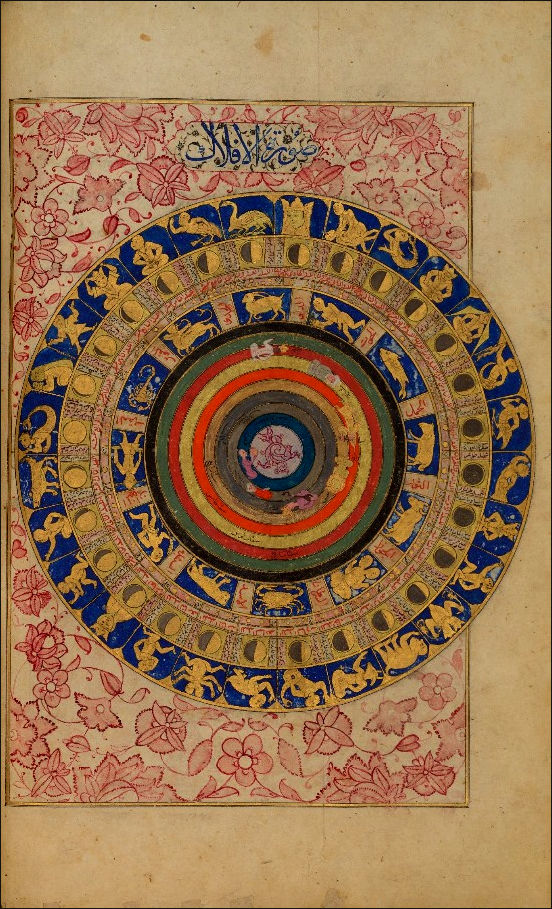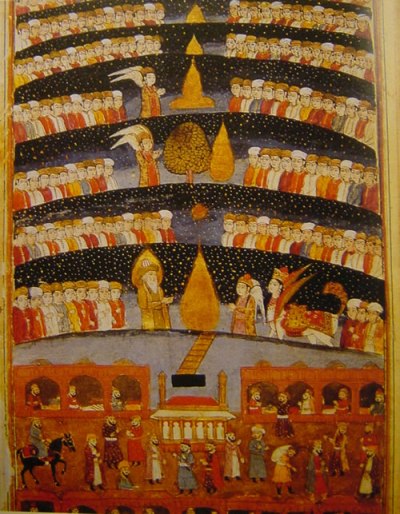
Celestial map, signs of the Zodiac and lunar mansions in the Zubdat-al Tawarikh, dedicated to the Ottoman Sultan Murad III in 1583
First and foremost, I’m fascinated that a book on the natural world is prefaced with a painting of how that world is both sustained and came into being. The Celestial Map or Macrocosm above is the opening miniature in the Turkish Zubdat al Tawarikh or History of the World commissioned by the Ottoman Sultan Murad III. These very fine paintings were on vellum and the work was completed C. 1583.
The visual arts and astrology have long been inseparable. The earliest star-lore was depicted visually in Sumer and far back into the Paleolithic period. The movements of the Heavens has always been of great importance and one picture really can be worth a thousand words when it comes to explaining Cosmologies.
Today, what we call history is not prefaced with a primary reference to the mystical creation. This makes these works most intriguing because they offer us a window into a mostly forgotten, but essential cosmologies. That is because we live in what we think is a linear, largely material reality. Other cultures, including the Turks, believed that time unfolded in spirals.

Miniature painting of a parade of two riding Gazi – Veterans from Rumelia – in front of Sultan Murat III from the Surname Ihümayun 16th century CE
Most importantly, we no longer live with the concept of divine origin. Traditional Astrology is very much aware of this reality The image contains an enormous amount of information. Most fundamentally, we have circles within circles At the centre is the source. Next the seven planets and luminaries are shown in their orbits following the Chaldean order. Beyond the orbit of Saturn have the realm of the Fixed Stars and it appears that the artist has chosen to place the zodiac beyond the black circle.
The seven planets and luminaries are shown in their orbits following the Chaldean order in a spiral. Beyond the orbit of Saturn we have the realm of the Fixed Stars and it appears that the artist has chosen to place the zodiac beyond the black circle.
What makes this a particularly fine work, is that it includes the Decans in relation to Lunar Phases as well as the twenty-eight Lunar Mansions, with Angels guarding the Four Directions.
Although the style is very much Turkish and Islamic in style, it is entirely recognizable as what has become known as the Ptolemaic Universe, The relationship between this cosmology and the Night Journey of Muhammad will become clear.
Muhamad’s Night Journey is in Sura Al Nisra of the Quran and further embellished in the Hadiths It’s controversial these days. Many modern Muslims consider this to be a literal event that occurred at a particularly time and place. – The Prophet rides on Buraq as is taken to Jerusalem where he ascends to meet the various Prophets from what is now known as the Dome of the Rock.
The mystical version has is that the Prophet rose through levels of consciousness. In either case, there is an ascent of Seven spheres, an essential theme that has repeated over and over again. In Ayat 11 we have the following exhortation “And We have made the night and day two signs, and We erased the sign of the night and made the sign of the day visible that you may seek bounty from your Lord and may know the number of years and the account [of time]. And everything We have set out in detail.”
This and other passages in the Quran support astrology as a guide to the wise. The usual context is in ‘to show the way’ which clearly refers to the use of stars in navigation but also implies other uses, such as choosing the correct time for an event,, medical diagnosis military matters and affairs of State. If this were not the case, Islam would have had no cause to compose the type of artwork that we see here, or produce some of the finest astrologers in the Middle Ages and beyond.
The exhortations against astrology are most specifically related to attempting to know such things as the time of the last day and the resurrection. This is the prerogative of the Creator. Common fortune telling won’t find any more support in the Quran as it does in the Bible. Indeed, many sects of Christianity regard astrology as forbidden. In much of my work, I have tried to show the massive difference in intent, method, and applications of divination compared to the disreputable and unwise world of fortune telling.
Imagine for a moment that you visit your physician and she tells you that you have a serious illness and may not have long to live. That physician has just made a prognostication based on medical knowledge. This could be construed as prediction and in fact, it is. When a skilled astrologer reads a chart it for many of the same reason a medical professional might be consulted. Questions about physical, spiritual and mental health can and are addressed by competent astrologers. Likewise, you might be concerned about making a choice between two or more things. The astrologer won’t make the choice for you, but they can offer very valuable information
Likewise, you might be concerned about making a choice between two or more things. The astrologer won’t make the choice for you, but they can offer very valuable information There is time to seed and a time to reap. One of the greatest uses of astrology are, as far as I’m concerned, is in the medical field. Knowing your humour, the strengths and weakness you have are all sound applications of the Celestial Science. If you read scripture carefully, you will not find thes4e applications of astrology to be forbidden.
Above, we what is essentially the sane theme found in the previous paintings, but with a slight twist. This Persian Sufi painting describes the Night Journey of the Prophet. This work is far more complex than first meets the eye. The painting has deteriorated, but we can still see the planets, represented anthropomorphically. The Sun and Moon are represented as disks. occupying the first and fourth sphere, as per the Chaldea order. We can also see the constellations, but they are projected in such as a way that we have the illusion of looking through the spheres. Remember that this is illustrating Muhammad’s mystical Night Journey.
Returning to the Quranic position on astrology, let’s examine a few more quotations. There is a Sura in the Quran known as Buruj, an Arabic word meaning ‘Constellation’ or ‘Zodiac sign’. Surah Buruj is the 85th Surah in the Quran. The starting of the Surah is : “I swear by the sky where there are buruj…” (i.e Allah swears by th sky where are zodiac signs.)
“I have created buruj [Zodiac signs] in the sky and decorated them for viewers and I have also protected them from evils…” (Surah Hizr 16)
“How great he is, who has created buruj in the sky and placed the Sun and shining Moon over there…” (Surah Furkan 61 )
In Arabic Astrology, we find that the sign Leo is named ‘Asad Buruj’. ‘Asad’ means a lion thus the Arabic name of Leo, which is represented by a lion, is ‘Asad Buruj’. Similarly, Libra is named, ‘Meejan Buruj’. The Arabic word ‘Meejan’ means a balance.
The emphasis on the creation of constellations, given the context we have, does nothing to indicate that a study of the same is somehow haram.
Finally, we can take a brief survey of some of Islam’s most esteemed astrologer. Most are surprised to find that the poet Omar Khyyam was an accomplished astrologer(1019-1135) He was a an astrologer of Khorasan. He was so accurate in his predictions that he even understood about his own death. This isn’t exactly the same as knowing the time of his death, but points to a deep understanding of the art. Many will be familiar with Sahl Ibn Bishr, Al Kindi, Ibn Arabi, Al Biruni and others.
However, I think the crown should go to Ibn Sina (980-1037) He was brilliant Muslim scientist who developed Alchemy. He was also very much devoted to astronomy and astrology, but other than his prolific philosophical works his contributions to medicine are immeasurable. His massive pharmacopeia is still in use among medical astrologers and natural healers.
This may seem trivial to some, but we have a great deal at stake worldwide. Literal Fundamentalism is not compatible with peace and has the effect of numbing the mind. The golden age of Islam did not flourish because of a stricter adherence to Shariah, as is commonly thought by contemporary Muslims, but because it was a period of openness, serious study of Classical antiquity and a willingness to work with people of divergent faiths and ethnicities.




